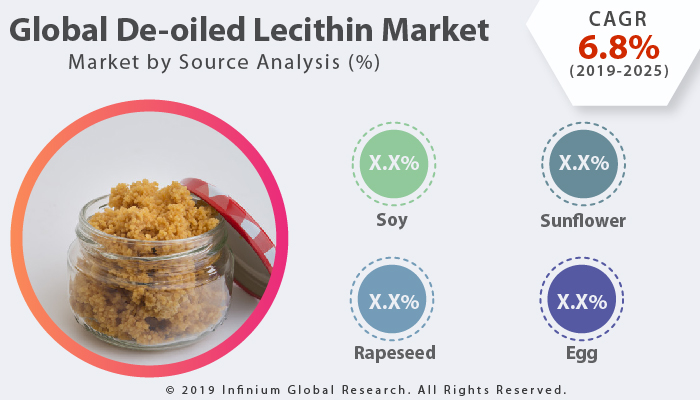De-oiled Lecithin Market (Method of Extraction - Acetone Extraction, Carbon Dioxide Extraction, and Ultrafiltration Process; Source - Soy, Sunflower, Rapeseed, and Egg; Application - Food, Feed, and Healthcare): Global Industry Analysis, Trends, Size, Share and Forecasts to 2025
A recent report published by Infinium Global Research on de-oiled
lecithin market provides an in-depth analysis of segments and sub-segments in the
global as well as regional de-oiled lecithin market. The study also highlights
the impact of drivers, restraints, and macro indicators on the global and
regional de-oiled lecithin market over the short term as well as long term. The
report is a comprehensive presentation of trends, forecast and dollar values of
global de-oiled lecithin market. According to the report, the global de-oiled
lecithin market is projected to grow at a CAGR of 6.8% over the forecast period
of 2019-2025.
Market Insight
De-oiled lecithin is a healthy food product obtained from
lecithin. This contains a high amount of concentrated polyunsaturated fatty
acids and is a relatively oil-free product. This is available in the powder and
granular form. Further, this is the rich source of the several essential ready
nutraceutical ingredients. The regular consumption of de-oiled lecithin
products provides several nutritional benefits to regular consumers. The
growing awareness about regular consumption of the health benefits of the
de-oiled lecithin products is helping to grow its application in several foods
and bakery products. Further, its application in the pharmaceutical and feed
industry is growing increasingly. Moreover, de-oiled lecithin product is used
in several dietary food products as cheese products, dietary instant products,
nutritional bars, energy bars. Additionally, these are used as dispersant,
anti-oxidants, emulsifiers, wetting agents, instantizing agents, viscosity
modifiers, lubricants, and release agents.
The growing demand for the different type of healthy food
ingredients among the consumers is helping to grow the demand of the de-oiled
lecithin products around the world. Further, the growing demand of the less
oil-based products to avoid extra fat and cholesterol is helping to grow the
demand of the de-oiled lecithin based products. However, the lack of awareness
about the di-oiled lecithin among the consumers in the developing countries is
hampering the growth of the market.
Geographically, the de-oiled lecithin market is segmented into
four regions namely North America, Europe, the Asia-Pacific, and RoW. The
North America is the largest market of de-oiled lecithin products, owing to the
presence of numerous food processing, feed manufacturing, chemical and pharmaceutical
companies in this region. Europe is the second largest market of the de-oiled
lecithin products, after North America. The Asia-Pacific market is expected
to grow at the highest CAGR during the forecast period, owing to the growing
demand of the different type of de-oiled lecithin based products.
Segment Covered
The report on global de-oiled lecithin market covers segments such
as method of extraction, source, and application. On the basis of method of
extraction, the sub-markets include acetone extraction, carbon dioxide
extraction, and ultrafiltration process. On the basis of source, the
sub-markets include soy, sunflower, rapeseed, and egg. On the basis of
application, the sub-markets include food, feed, and healthcare.

Companies Profiled:
The report provides profiles of the companies in the market such
as Rasoya Proteins Ltd, Novastell, GIIAVA (INDIA) PVT. LTD, Lasenor Emul,
Levital GmbH, American Lecithin Co, LECICO GmbH, Stern-Wywiol Gruppe GmbH &
Co. KG, Bunge Limited, and DuPont de Nemours, Inc.
Report Highlights:
The report provides deep insights into the demand forecasts, market trends, and micro and macro indicators. In addition, this report provides insights into the factors that are driving and restraining the growth in this market. Moreover, The IGR-Growth Matrix analysis given in the report brings an insight into the investment areas that existing or new market players can consider. The report provides insights into the market using analytical tools such as Porter's five forces analysis and DRO analysis of de-oiled lecithin market. Moreover, the study highlights current market trends and provides forecast from 2019-2025. We also have highlighted future trends in the market that will affect the demand during the forecast period. Moreover, the competitive analysis given in each regional market brings an insight into the market share of the leading players.
